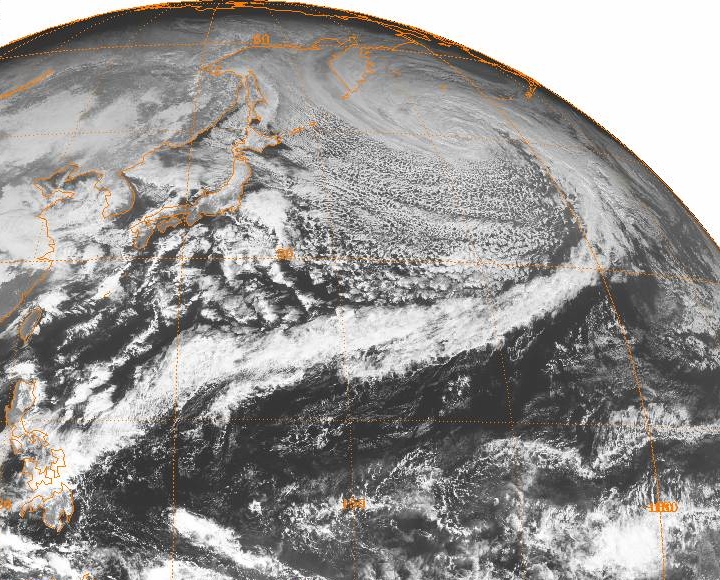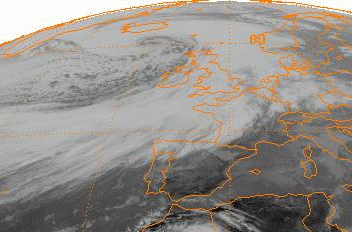|
January 2013 Northwest Pacific Cyclone
The January 2013 Northwest Pacific cyclone was a powerful extratropical cyclone which caused heavy rainfall and a severe blizzard in Japan in January 2013. Forming northeast of Taiwan on January 13 and absorbing Tropical Depression Bising soon afterward, the storm quickly intensified in the southern sea off Japan on January 14, and reached its peak intensity east of Japan on January 15, with its central atmospheric pressure decreasing to . The system then weakened, crossed the Kamchatka Peninsula late on January 18, and dissipated east of Hokkaido on January 21. Meteorological history At 0000 UTC on January 13, an extratropical cyclone formed northeast of Taiwan, and the Japan Meteorological Agency (JMA) started to issue storm warnings on the developing low; 18 hours later, the storm southeast of Kyushu absorbed Tropical Depression Bising which formed near the Philippines. Fed by the remnants of the tropical depression's huge amounts of heat and vapor, the storm quickly inte ... [...More Info...] [...Related Items...] OR: [Wikipedia] [Google] [Baidu] |
Extratropical Cyclone
Extratropical cyclones, sometimes called mid-latitude cyclones or wave cyclones, are low-pressure areas which, along with the anticyclones of high-pressure areas, drive the weather over much of the Earth. Extratropical cyclones are capable of producing anything from cloudiness and mild showers to severe gales, thunderstorms, blizzards, and tornadoes. These types of cyclones are defined as large scale (synoptic) low pressure weather systems that occur in the middle latitudes of the Earth. In contrast with tropical cyclones, extratropical cyclones produce rapid changes in temperature and dew point along broad lines, called weather fronts, about the center of the cyclone. Terminology The term " cyclone" applies to numerous types of low pressure areas, one of which is the extratropical cyclone. The descriptor ''extratropical'' signifies that this type of cyclone generally occurs outside the tropics and in the middle latitudes of Earth between 30° and 60° latitude. They are term ... [...More Info...] [...Related Items...] OR: [Wikipedia] [Google] [Baidu] |
Bomb (meteorology)
Explosive cyclogenesis (also referred to as a weather bomb, meteorological bomb, explosive development, bomb cyclone, or bombogenesis) is the rapid deepening of an extratropical cyclonic low-pressure area. The change in pressure needed to classify something as explosive cyclogenesis is latitude dependent. For example, at 60° latitude, explosive cyclogenesis occurs if the central pressure decreases by or more in 24 hours. This is a predominantly maritime, winter event, but also occurs in continental settings, This process is the extratropical equivalent of the tropical rapid deepening. Although their cyclogenesis is entirely different from that of tropical cyclones, bomb cyclones can produce winds of , the same order as the first categories of the Saffir–Simpson scale, and yield heavy precipitation. Even though only a minority of the bomb cyclones become so strong, some weaker ones have also caused significant damage. History In the 1940s and 1950s, meteorologists at the Berg ... [...More Info...] [...Related Items...] OR: [Wikipedia] [Google] [Baidu] |
November 2011 Bering Sea Cyclone
The November 2011 Bering Sea cyclone was one of the most powerful extratropical cyclones to affect Alaska on record. On November 8, the National Weather Service (NWS) began issuing severe weather warnings, saying that this was a near-record (or record) storm in the Bering Sea. It rapidly deepened from to in just 24 hours before bottoming out at 943 mbar (hPa; 27.85 inHg), roughly comparable to a Category 3 or 4 hurricane. The storm had been deemed life-threatening by many people. The storm had a forward speed of at least before it had reached Alaska. The storm began affecting Alaska in the late hours of November 8, 2011. The highest gust recorded was on Little Diomede Island. One person was reported missing after being swept into the Bering Sea, and he was later pronounced dead. Meteorological synopsis In early November 2011, an extratropical cyclone developed over the western Pacific Ocean. Gradually intensifying, the system moved rapidly northeastward at a ... [...More Info...] [...Related Items...] OR: [Wikipedia] [Google] [Baidu] |


